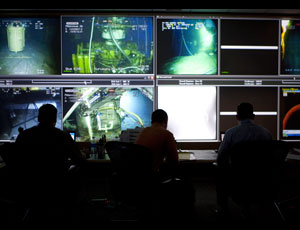BP kept a lid on its run-away Mancondo well in the Gulf of Mexico July 20, despite four leaks that have developed in and around it since July 14, when BP closed newly-installed shut-off valves on the well.

BP and the government believe the well retains integrity and have agreed to continue tests in 24-hour increments with the cap in place and valves closed, officials say. The well blew out April 20 in a fiery disaster that killed 11 workers on the drill ship Deepwater Horizon.
Federal overseers agree the “seepage” is not consequential enough to signal a loss of integrity of the wellbore, although officials are watching closely. Two sources are at the wellhead and equipment installed on it, and two others are “ a few thousand feet” and two miles away, respectively, on the seabed. Emergency response officials say it is not certain the two remote leaks are related to the Mancondo well.
BP says one area of seepage consists of gas bubbles coming from the 36-inch-dia well casing. Kent Wells, a BP official, says the bubbles are nitrogen from the casing cement. A second source of seepage is the blow-out preventer; it likely consists of natural gas and some oil, BP and the federal officials say.
Wells says BP may seek permission to attempt a “top kill” again, as it did May 26. For a top kill, drilling mud is pumped down into the well to force the oil back into the reservoir. This time the method would be a “static” top kill, since the well no longer is gushing.
Officials say the odds of successfully choking the well with mud and concrete are improved because the pressure in the wellbore—6811 psi and rising about a pound an hour—is lower than before
Even if a new top kill stops the well flow, Wells says a relief well to intersect the bore 18,000 ft below the sea surface will still be necessary to permanently close it.
On July 20, the first of two relief wills was in position to make the attempt. “We’re absolutely perfectly positioned. The team is feeling very good about how they’ve set this well up,” Wells says. Crews are now enlarging the hole and running in casing. Then they will begin “ranging runs” with the drill head to determine exactly how close they are to the wellbore.
“I believe we will be having an intersect at the end of July,” Wells says.

Post a comment to this article
Report Abusive Comment